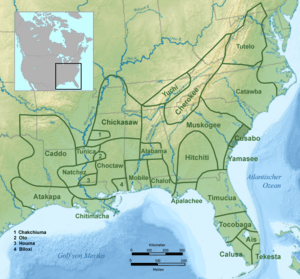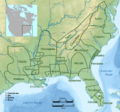Cusabo facts for kids

Where the Cusabo lived in the 1600s
|
|
| Total population | |
|---|---|
| No longer exist as a separate group | |
| Regions with significant populations | |
| South Carolina, United States | |
| Languages | |
| Cusabo language | |
| Religion | |
| Native American beliefs | |
| Related ethnic groups | |
| Unclear, possibly Muskogean or Arawakan speakers |
The Cusabo (also called Cosabo) were a group of Native American tribes. They lived along the Atlantic Ocean coast in what is now South Carolina. This was roughly between today's Charleston and the Savannah River.
When European settlers arrived, the English often called them "Settlement Indians." This meant they lived near the colonists. Five of these groups spoke a language that was different from other major languages nearby. These included Algonquian, Iroquoian, Muskogean, and Siouan.
When the English started settling in Charleston in the 1600s, the Cusabo had a difficult relationship with the new colony. After the Yamasee War in 1715, the remaining Cusabo people joined other tribes. Many went to live with the Muscogee or Catawba.
Contents
Who were the Cusabo tribes?
The Cusabo were made up of several smaller tribes. These included:
- Ashepoo (Ishpow)
- Combahee
- Cusso (also Coosaw or Kussoe)
- Edisto (also Edistow)
- Escamacu (also St. Helena Indians)
- Etiwaw tribe (also Etiwan, Ittawan or Eutaw)
- Kiawah
- Stono
- Bohicket
- Wando
- Wappoo
- Wimbee
Other Native American groups who lived near the settlers but were not Cusabo included the Sewee and Santee.
What language did the Cusabo speak?
| Cusabo | |
|---|---|
| Region | South Carolina |
| Extinct | 18th century |
| Language family |
unclassified
|
The Cusabo language is mostly unknown today. It became extinct in the 1700s. It did not seem to be related to other known languages in North America.
Some experts once thought it might be part of the Muskogean language family. But newer research suggests it was not.
There is proof that at least five coastal tribes spoke a common language. This language was different from the Guale and Sewee languages. It was likely spoken by the Ashepoo, Combahee, Escamaçu, Etiwan, and Kiawah. This language is sometimes called Cusaboan.
Only a few words of Cusabo were written down. A French explorer named René Goulaine de Laudonnière recorded some in the 1500s. For example, Skorrye or Skerry meant "bad" or "enemy." Most of the recorded words do not have translations. About 100 place names and 12 personal names in Cusabo still exist.
These place names do not seem to be like those in Algonquian, Siouan, Iroquoian, or Muskogean languages.
Some scholars have suggested that the Cusabo language might be related to the Arawakan languages. These languages are spoken by native peoples from the Caribbean islands and South America. If this is true, it would mean that some parts of the North American Atlantic Coast were settled by people from the Caribbean.
History of the Cusabo
The names of many Cusabo tribes were first written down in the 1500s. This happened when a native man named Francisco de Chicora was taken to Spain. He told a storyteller about the lands and tribes he knew.
The English colony of South Carolina was started in 1670. It was built right in the middle of Cusabo land. This made the Cusabo tribes closely connected to the new colony.
In the first few years, there was fighting between some Cusabo tribes and the English. The Kussoe tribe was the first to fight the colonists in 1671. The Kussoe hid, but they stayed in the area.
In 1674, another Cusabo tribe, the Stono, also fought with the colony. The colonists won these conflicts. They forced the tribes to give up large areas of their land. The Kussoe also had to pay a small tribute of one deerskin every month.
The Kussoe, Stono, and other Cusabo tribes lived mostly peacefully with the colonists after this. This lasted until the Yamasee War in 1715.
The Westo tribe was an early ally of South Carolina. They often attacked other Native American groups to capture people for slavery. By the late 1670s, South Carolina told the Westo to stop attacking the Cusabo. The colony then worked with other Native American groups to defeat the Westo in 1679-1680.
By the early 1700s, the Cusabo had become part of South Carolina's colonial life. They kept their tribal identities and lived in their own villages. The Cusabo helped the colonists as a kind of police force. They were paid with trade goods, weapons, and money.
The colony paid the Cusabo to hunt animals like wolves and bears. The Cusabo also hunted other animals and sold the meat to the colonists. But their main job was to catch enslaved Africans who had run away. The colonists wanted to create bad feelings between the Cusabo and the enslaved Africans. This was to stop them from working together.
During the Tuscarora War (1711-1712), the Cusabo joined the South Carolina army. They fought against the Tuscarora in North Carolina. The Cusabo warriors were a small group, fewer than 15 men.
In 1712, South Carolina gave Polawana Island to the Cusabo. Many Cusabo were already living there. In 1715, a count showed that the Cusabo lived in five villages. They had about 95 men and 200 women and children. The Itwan, a Cusabo subtribe, lived in one village with 80 men and 160 women and children.
During the Yamasee War of 1715, the Cusabo were one of the few Native American groups who sided with South Carolina. After the war, most Cusabo left the area. They joined either the Catawba or the Muscogee tribes.
Cusabo today
Today, some groups say they are descended from the Cusabo people. These include the Guaymari Kiawah and the Varnertown Indians. South Carolina recognizes the Wassamasaw Tribe of Varnertown Indians as a state-recognized tribe. However, they are not recognized by the United States government. The Guaymari Kiawah are not recognized by the state or federal government.
Images for kids


